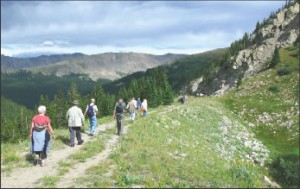There was a time when I felt close to the leading edge of digital technology. That was a quarter of a century ago, in 1984, when I was one of the first Salidans to work with a genuine personal computer.
The computer was an Osborne I. It had two 5.25-inch floppy drives, a tiny 5-inch screen, an 8-bit Z80 CPU, and a full 64-kilobytes of RAM.
It was not state-of-the-art, even then. The IBM PC was faster and potentially much more powerful with its expansion capacity, and Apple had just come out with is first easy-to-use Macintosh.
But Salida was something of a backwater in those days, so it didn’t take a lot of computing horsepower to be a local leader. Plus, the Osborne was a great teaching tool. In order to get its bundled word-processing program (good old WordStar) to work with a given printer, you had to get the control codes (for bold face and the like) from the printer’s manual, then patch them into WordStar with a hex editor.
The “hex” did not refer to spells cast by gypsies; it was short for “hexadecimal,” a numbering system based on 16 instead of the usual 10, our decimal system. Along the way, one also got used to working in binary (2 based) and octal (8 based).
This was rather arcane stuff for a one-time English major, but I’d always been pretty good at math, at least until I hit calculus in 12th grade. After I managed to get my Okidata M92 dot-matrix printer to go through its paces with my home-patched WordStar, I felt confident in my ability to tackle other computing challenges.
Some challenges took some serious work. I had read about computer bulletin boards, accessed via modem over telephone lines. I bought a modem that ran at all of 300 bits per second. I soldered a serial cable to connect it to the computer (to this day, every time I burn myself while soldering, I think “I was an English major. This was never supposed to happen to me.”)
I poked my way around a communications program called OTERM, and I still remember the thrill the first time I connected with a remote system, and how exciting it was to transfer files with the Xmodem protocol.
Thus empowered, I signed up for CompuServe. Thanks to quirks in the regulation of telephone rates back then, it was cheaper to make out-of-state calls than in-state. In other words, it cost more to call Westcliffe from Salida than it cost to call New York City from Salida. So instead of accessing Compuserve at Colorado Springs, the closest node, I went through Los Alamos, N.M.
We had an active users’ group here, the Chaffee County Computer Club, and for about 10 years, I put out its newsletter, SCUM (allegedly an acronym for Salida Computer Users Monthly). I learned lots of stuff at our meetings, made some friends, and sometimes picked up some consulting work, helping with local computer installations.
Nowadays computers are appliances, not novelties; try to imagine the need for something like a Microwave Oven Users Group or a Compact Fluorescent Lamp Lighters Association, and you’ll see what I mean.
We have broadband Internet access. Hardly anybody uses modems and CompuServe is being shut down by its owner, AOL. I use email a lot and I can make static web pages; I use a nice, fast home-built computer with a 64-bit CPU and 2 gigs of RAM, but I am nowhere near the vanguard any more.
In other words, nobody calls me any more for computer advice or guidance. Part of that is self-inflicted, as I generally use GNU/Linux instead of the Microsoft Windows that nearly everyone else uses.
At any rate, I’m seriously out of it. I’ve never looked at a MySpace page. I’ve never “texted” anyone, or been texted myself. For the longest time, I thought on-line locutions like “pwn” and “teh” were typos, not deliberate usages.
I do venture to one Facebook locale, because that’s where I can see pictures of my one-year-old grandson, Ezra (who is, of course, the most charming baby in the observable universe). I have learned the blog a little for High Country News at its GOAT site, but find the mechanics of the process annoying and frustrating.
And then, in a recent edition of Time, I read that some other digital communication process that I know little or nothing about, Twitter, is going to change the way we live.
If I understand this correctly, you send something called a “tweet” to Twitter. On account of technical specifications that I have not taken the time to understand, maximum size of a tweet is 140 characters (back in the day, we called them “bytes,” but these days that nomenclature would mark you as a technological elitist). People can enroll to get your tweets, which appear almost instantly after you send them. Thus you can go through your day tweeting, and people can follow your day almost moment by moment.
To be quite honest, I don’t care what you had for breakfast, or what you’re thinking when you choose clothes for the day, or how you respond to the pep talk at a staff meeting. But what the hell:
6:48 a.m.
Bladder wakes me. Empty it. Can’t get back to sleep. Might as well face the day.
6:52 a.m.
Damn cats want fed. Will not stop meowing until I fill bowl. Cat walks away without eating anything. Resist desire to throw boot at cat.
6:54 a.m.
Grind coffee beans. The improved taste is worth the hassle. Why do beans cost so much more than ground coffee in a can, as whole
6:55 a.m.
beans are less work for the coffee company? Think of Civil War soldiers grinding their own coffee. The federal government at
6:56 a.m.
first bought ground coffee, but it was so adulterated with flour and crud that the War Department switched to whole roasted beans.
6:58 a.m.
Wait, this isn’t supposed to be about coffee. It’s supposed to be about ME and how INTERESTING my life must be. Dog wants out.
7:02 a.m.
Dog wants in. Grab first cup of coffee. Start breakfast, oatmeal with vanilla soy milk and orange juice.
7:04 a.m.
Wonder why most guys my age that I know eat oatmeal for breakfast. For me it tastes too good to be good for me. Start reading papers.
7:14 a.m.
Dog wants in. Martha comes downstairs. Asks if I’m enjoying my “breffest.” She grew up in Michigan, where the k is silent in breakfast.
7:16 a.m.
Dog is in. Cats are pissed about it and demand petting. You can have cats or you can have mice, and cats don’t crap in your cereal.
7:23 a.m.
Fire up computer. Why don’t I think “boot up?” Probably from working in laundries where the workday started with firing up th
7:24 a.m.
e boiler, and so to me you fire up machinery to get going. Odd how locutions persist.
7:30 a.m.
Had to reboot wireless router leased from Qwest. Sometimes it goes for months. Sometimes 2-3 reboots a day. Annoying as hell.
7:38 a.m.
72 new emails. Most in cyrrilic letters. Some in various Asian scripts. Others offer “genuine replica” Rolex watches. Two accusing me o
7:39 a.m.
f supporting terrorists because I oppose torture. One missive from old friend. Start to answer when Martha calls me to back wind
7:40 a.m.
ow to see two squirrels humping in the plum tree. Should learn to take movies on the cell phone so we could post this natural specta
7:41 a.m.
cle on Utube. Return to answering email, or would be if I were not tweeting. How do you get anything done when you’re busy writi
7:42 a.m.
ng what you do instead of doing it? Phone rings. My newest vehicle is a 2000 model. Warranty expired long ago. Phone
7:43 a.m.
rings again. My brick house doesn’t need new siding. What part of “Do Not Call” do these bastards not understand?
7:53 a.m.
Another call. Tempted to let machine get it but answer anyway. It’s Mike Rosso, wants my column for next edition. Tell him I’m so busy
7:54 a.m.
tweeting that he’ll have to wait. He says to send what I have as he’s nearing press deadline. I understand perfectly. Here goes.
Ed Quillen does not tweet from his home in Salida, or anywhere else. He is a regular op-ed columnist for the Denver Post and a frequent contributor to High Country News, and helped found Colorado Central Magazine in 1994.


